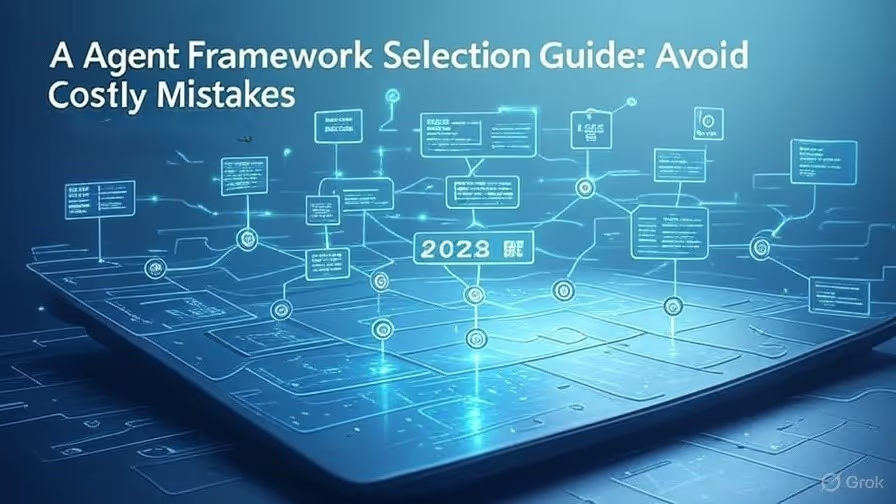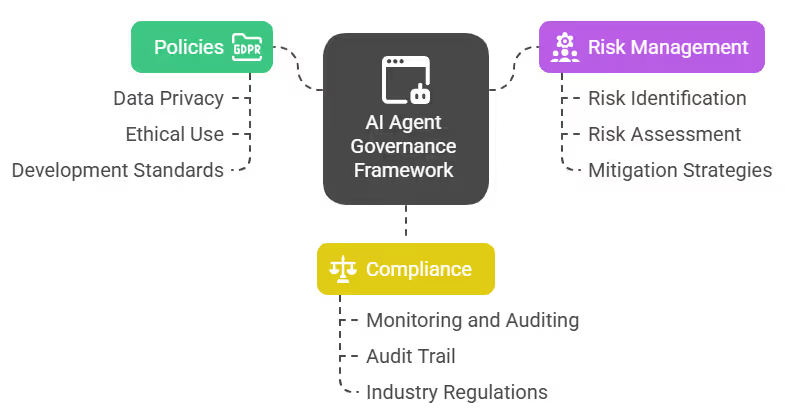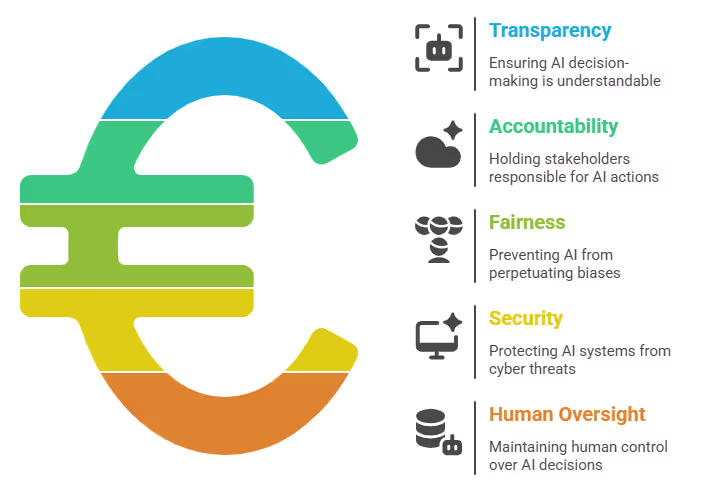AI Agent Governance Framework

AI agents are rapidly transforming how businesses operate, but without a governance framework, they pose risks around bias, compliance, and accountability. For US enterprises, an AI agent governance framework provides the structure to deploy AI responsibly, balancing innovation with transparency, ethics, and regulatory compliance. This guide explains what it is, why it matters, and how to implement it effectively.
What is an AI Agent Governance Framework?
An AI Agent Governance Framework is a structured system of principles, rules, and practices designed to manage and oversee the development, deployment, and operation of AI agents. It ensures that these agents are built and used in a way that is ethical, safe, transparent, and compliant with relevant regulations and organizational standards. The framework provides the necessary guardrails to manage the unique risks associated with autonomous AI systems, such as accountability issues, data privacy concerns, and potential biases.
⚠️ Is Your AI Agent Governance Strategy Future-Proof?
Download our AI Governance Checklist for Enterprises, a free resource to help you assess compliance, security, and control across your AI agents.
✅ Avoid risk | ✅ Stay compliant | ✅ Improve oversight
📥 Get the Checklist Now
What is a Framework?
A framework, in this context, is a conceptual blueprint or a foundational structure that provides a set of guidelines and best practices. It's not a rigid set of rules but rather a flexible system that an organization can adapt to its specific needs to ensure consistency and control across various AI initiatives.
- A framework defines the "what" and "how" for managing AI agents, outlining the necessary components and processes for responsible use.
- It serves as a single source of truth for all stakeholders, from developers and data scientists to legal and business teams, ensuring everyone is aligned on the same principles.
- By establishing clear roles, responsibilities, and decision-making processes, it helps to mitigate potential risks before they become significant problems.

Core Elements of AI Agent Governance Framework
The three main pillars of an effective governance framework are policies, risk management, and compliance.
Policies: These are the internal rules and guidelines that dictate how AI agents should be handled within an organization.
They address critical areas such as:
- Data privacy and security protocols to protect sensitive information.
- Ethical use policies that ensure fairness, transparency, and accountability.
- Agent development standards that specify quality control and documentation requirements.
Risk Management: This element focuses on identifying, assessing, and mitigating the potential negative impacts of AI agents. It involves:
- Proactively identifying risks like algorithmic bias, system failures, and unintended consequences.
- Establishing a risk assessment process to evaluate the severity and likelihood of these risks.
- Developing mitigation strategies and contingency plans to address identified vulnerabilities.
Compliance: This ensures that all AI agent activities adhere to both internal policies and external laws and regulations. Key aspects include:
- Monitoring and auditing agent behavior to ensure it aligns with legal requirements, such as GDPR or other data protection acts.
- Maintaining a clear audit trail of decisions and actions taken by AI agents for accountability.
- Ensuring adherence to industry-specific regulations and standards, like those in finance or healthcare.
By integrating these core elements, an AI Agent Governance Framework provides a robust system for organizations to innovate with AI safely and responsibly.
🧠 Struggling with AI Agent Governance in Your Org?
We help CTOs and AI leaders design secure, scalable, and auditable AI agent systems that align with both technical and regulatory demands.
👉 Book a free 30-minute strategy consult, no pressure, just real guidance.
Schedule Your Session
Why AI Governance Matters for US Enterprises
AI governance is a crucial framework for US enterprises to manage the development, deployment, and use of artificial intelligence in a responsible and ethical manner. As AI becomes more integrated into business operations, establishing clear governance policies is no longer optional, it's a necessity for mitigating risks, ensuring compliance, and building public trust.
A robust governance strategy helps companies navigate the complex and evolving regulatory landscape while safeguarding their reputation and financial stability.
Navigating the Regulatory Landscape
- The Federal Trade Commission (FTC) has been actively monitoring AI use, focusing on issues of fairness, bias, and transparency. The FTC can take enforcement action against companies that engage in deceptive or unfair practices related to their AI systems, such as making unsubstantiated claims about a product's AI capabilities or using AI in a way that leads to discriminatory outcomes.
- While not a US law, the European Union's AI Act has a significant global impact. It classifies AI systems based on risk level and imposes strict requirements on high-risk AI, which can affect US companies that offer services or products in the EU. This pushes American enterprises to adopt similar risk-based governance models to ensure international compliance.
- The National Institute of Standards and Technology (NIST) has provided voluntary guidelines, most notably the AI Risk Management Framework (AI RMF). This framework helps organizations manage the risks associated with AI throughout its lifecycle. Adopting these guidelines demonstrates a proactive approach to ethical AI and can serve as a strong defense in a litigious environment.
Business Risks of Ignoring Governance
- Ignoring AI governance exposes companies to significant legal and financial risks. This includes hefty fines from regulatory bodies for non-compliance, as well as costly lawsuits stemming from biased AI decisions that harm consumers or employees. A single class-action lawsuit can have a devastating financial impact.
- A lack of governance can lead to severe reputational damage. Public trust in a company can be eroded quickly if its AI systems are found to be unfair, biased, or opaque. Negative press and public backlash can lead to customer churn, a drop in stock price, and difficulty attracting top talent.
- Poorly managed AI systems can introduce operational inefficiencies and security vulnerabilities. Without proper oversight, AI models may produce inaccurate results, make biased recommendations, or be susceptible to adversarial attacks. This can compromise data security and lead to poor business decisions, undermining the very purpose of using AI.
Core Principles of AI Agent Governance
Governing AI agents requires a clear set of principles to ensure they are developed and deployed ethically and safely. These principles help manage the risks associated with autonomous systems and build public trust. The five core principles are transparency, accountability, fairness, security, and human oversight.
Adhering to these principles is crucial for preventing harm, promoting positive outcomes, and ensuring that AI serves humanity's best interests.

- Transparency
- This principle means making the inner workings of an AI agent understandable to humans.
- It involves documenting how the AI was trained, what data it used, and how it makes decisions.
- This is especially important in regulated industries like finance, where AI models are used for loan applications. For example, U.S. banks must be able to explain to regulators and applicants why an AI denied a loan, ensuring compliance with fair lending laws.
- Accountability
- Accountability holds developers, operators, and organizations responsible for the actions and outcomes of their AI agents.
- It defines who is liable when an AI system causes harm or makes a mistake.
- In the U.S. healthcare sector, this is critical. If an AI-powered diagnostic tool makes an error that leads to a misdiagnosis, the healthcare provider or the AI company can be held accountable, and this ensures patient safety and legal responsibility.
- Fairness
- This principle ensures that AI agents do not perpetuate or amplify existing human biases.
- It requires that AI systems treat all individuals and groups equitably, without discrimination based on race, gender, or other characteristics.
- An example is using AI in hiring and recruitment. U.S. companies must ensure their AI-powered resume screening tools do not favor certain demographics, which is a requirement under equal employment opportunity laws.
- Security
- AI agent security focuses on protecting the systems from malicious attacks, data breaches, and other cyber threats.
- It involves securing both the AI model and the data it uses to prevent unauthorized access or manipulation.
- In the defense and aerospace industries, AI agents are used for mission-critical tasks. The U.S. Department of Defense, for example, has strict protocols to protect AI systems from being hacked or compromised, which is essential for national security.
- Human Oversight
- This principle ensures that humans remain in control of AI agents, especially for high-stakes decisions.
- It requires that AI systems have a "human in the loop" who can monitor the AI's actions, intervene if necessary, and ultimately make the final decision.
- For instance, in the autonomous vehicle industry in the U.S., a human driver is often required to be ready to take control of the vehicle, even when the AI is driving. This maintains a layer of human judgment and control for safety.
Building an AI Agent Governance Framework
To build an AI agent governance framework, you need a clear, step-by-step approach that involves key roles and leverages specific tools and frameworks. This structure ensures that AI agents operate ethically, securely, and in compliance with regulations.
Step-by-Step Implementation
- Define Principles & Policies: Start by establishing core principles for responsible AI, such as fairness, transparency, and accountability. Based on these, create specific policies that guide the entire lifecycle of AI agents, from design to deployment and monitoring.
- Implement Technical Controls: Put in place technical safeguards to enforce the policies. This includes using secure data handling practices, implementing robust access controls, and using automated tools to monitor agent behavior for any deviations from the established guidelines.
- Establish a Review Process: Create a formal process for reviewing and approving all AI agent projects. This should involve a cross-functional team that assesses potential risks, ethical implications, and compliance requirements before an agent is developed or deployed.
- Monitor and Audit Continuously: Governance isn't a one-time task. You need to continuously monitor the performance and behavior of AI agents in real-time. Regular audits are essential to check for biases, ensure compliance, and verify that the agents are still aligned with business goals.
Roles and Responsibilities
- Compliance Officers: These professionals are responsible for ensuring that all AI agent activities adhere to both internal policies and external regulations, such as those from the FTC or state-level data privacy laws. They work closely with legal teams to interpret rules and translate them into actionable guidelines.
- AI Engineers: Their role is to implement the governance policies at a technical level. This includes building safeguards into the AI models, ensuring data is used ethically, and creating systems to log and report on the agent's actions. They are the primary executors of the framework.
- Leadership: Executives provide the necessary funding and strategic direction for the governance framework. They champion a culture of responsible AI and hold teams accountable for following the established policies, ensuring the framework is a priority across the organization.
Challenges in AI Agent Governance
- Bias in Data and Algorithms: AI agents can learn and perpetuate biases present in their training data. This can lead to discriminatory outcomes in areas like hiring, lending, or criminal justice. Ensuring fairness requires a continuous effort to audit data for representational biases and develop algorithms that are less susceptible to learning harmful stereotypes.
- Explainability and Transparency: Many advanced AI models, particularly deep neural networks, are "black boxes," meaning their decision-making processes are difficult to understand. This lack of transparency makes it challenging to pinpoint why an agent made a particular decision, hindering accountability and user trust. Efforts are underway to create more interpretable AI models and develop tools that can explain the reasoning behind a decision in a human-understandable way.
- Regulatory Uncertainty: The rapid pace of AI development has outstripped the ability of regulators to create clear and comprehensive legal frameworks. This uncertainty creates a challenging environment for businesses, as they must navigate a patchwork of emerging guidelines and potential future regulations, such as those concerning data privacy and liability for autonomous systems.
Case Studies: US Enterprises Applying Governance
Large US enterprises across various sectors are implementing governance to ensure their operations are efficient, secure, and compliant. This involves establishing frameworks and policies to guide decision-making and manage risks, especially as they adopt new technologies and handle vast amounts of data.
Finance Sector
- Goldman Sachs: This firm uses strong governance to manage financial and technological risks. They have comprehensive policies for data security, algorithmic trading, and ethical AI use. This is critical for protecting client information and maintaining market stability. Their Product Engineering Services often focus on building secure, scalable platforms that adhere to these strict regulatory standards.
- JPMorgan: The bank has a robust governance structure to manage its global operations. They focus on regulatory compliance, cybersecurity, and risk management across all their financial products. They've also been actively using generative AI chatbots to improve customer service and internal operations, all while under a strict governance framework to ensure data privacy and accuracy.
Healthcare Sector
- Mayo Clinic: As a leading healthcare provider, the Mayo Clinic uses governance to ensure patient data privacy and the integrity of medical research. Their governance models oversee the use of electronic health records (EHRs) and the implementation of new medical technologies. This ensures that all digital tools, including those built for patient portals or internal communication, meet strict healthcare regulations like HIPAA. Their approach guarantees data is handled ethically and securely.
Manufacturing Sector
- GE (General Electric): GE applies governance to manage its complex, global supply chains and industrial data. Their governance policies cover everything from data from IoT sensors on factory floors to the security of their industrial software. This helps them maintain product quality, ensure operational efficiency, and protect intellectual property.
- Siemens USA: The company uses governance to oversee its digital transformation efforts, especially in industrial automation and smart infrastructure. They have specific policies for cybersecurity, data management, and the ethical use of AI in manufacturing processes. This strict oversight helps them deliver reliable and secure solutions to their customers and ensures their internal operations are protected from cyber threats.
Future of AI Governance in the USA
Predictions & Trends
- A patchwork of regulations will continue to emerge.
- Since a single, comprehensive federal AI law is unlikely in the near term, regulation will be a "patchwork quilt."
- This includes a mix of executive orders, agency-specific guidelines, and a rush of state-level laws.
- States like California and New York are already enacting legislation on issues like transparency and consumer protection.
- The focus will be on specific, high-risk applications.
- Rather than regulating AI as a whole, the government will target its use in critical sectors.
- Areas like healthcare, finance, employment, and law enforcement will see more tailored rules.
- The goal is to mitigate specific risks such as algorithmic bias, discrimination, and privacy violations.
- The role of voluntary frameworks will grow.
- The National Institute of Standards and Technology (NIST) AI Risk Management Framework will play a central role.
- It provides a flexible, non-binding set of guidelines for companies to manage AI risks.
- This approach encourages private-sector innovation while promoting responsible development and deployment.
- There will be a push for transparency and accountability.
- Regulations will increasingly require companies to disclose when they use AI for consequential decisions.
- The aim is to make AI systems more explainable and auditable.
- This includes ensuring that people can understand and challenge decisions made by AI, especially in areas affecting their rights and safety.
Federal AI Policies
- The National AI Initiative Act of 2020 established a framework for federal AI efforts.
- It promotes AI research and development across various government agencies.
- This act highlights the US commitment to maintaining technological leadership.
- Executive Orders are a primary tool for federal action.
- Presidential executive orders direct federal agencies to establish standards and guidelines for AI use.
- They address issues from national security and public safety to promoting innovation.
- The Office of Management and Budget (OMB) is guiding agencies.
- The OMB provides specific directives for federal agencies on how to responsibly acquire and use AI technologies.
- This includes a focus on risk management, competition, and interagency collaboration.
What's Next
The AI agent governance framework is no longer optional, it is a necessity for US enterprises aiming to innovate responsibly. By embedding governance principles like transparency, fairness, and compliance, organizations not only mitigate risks but also strengthen trust with customers, regulators, and stakeholders.
The companies that lead in AI adoption will be the ones that govern it best.
Wrapping Up: Make a Choice That Works
Choosing an AI agent framework for your U.S. company is like picking the right tool for a tough job. We had seen projects in Chicago and Portland thrive or tank based on this decision.
Test hard, plan for integration pain, and don’t buy the hype.
Sometimes, going straight to APIs saves time and money, We had done it and kept clients happy.
Use these lessons from my late nights and tough calls to pick a path that delivers without drama.

